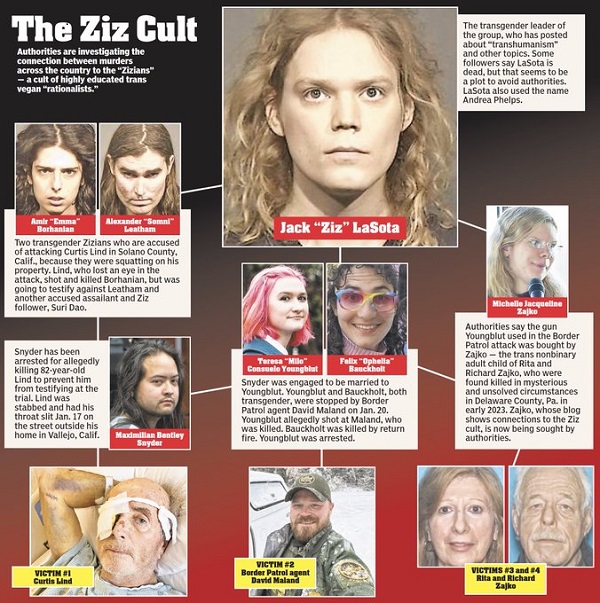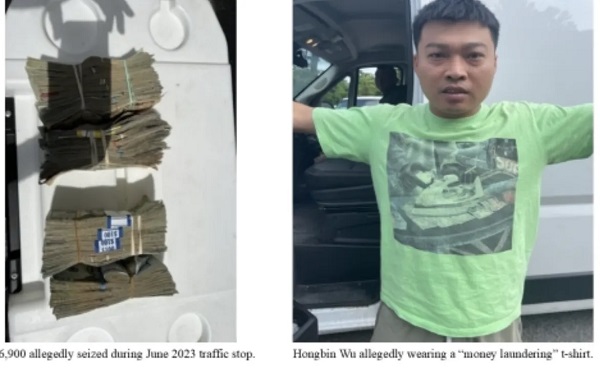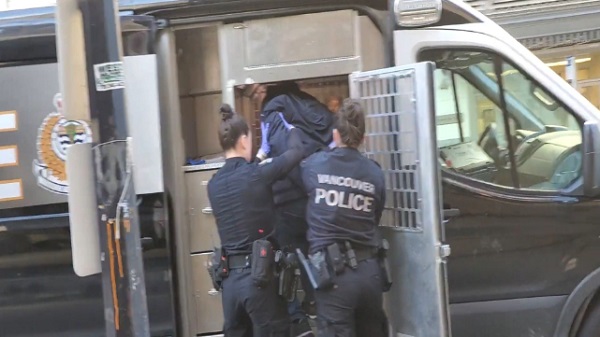Crime
Murder of US Border Patrol agent linked to bizarre ‘antifascist trans terror cult’

From LifeSiteNews
The bizarre behavior and extreme violence and murders by the Zizian ‘trans terror cult’ raises questions about the role of opposite sex hormones treatment.
A complex cross-country story, mostly ignored by corporate media, has been exposed by investigative journalist Andy Ngo who has shown that a series of murders from coast to coast are likely connected to members of a bizarre “radical leftist trans militant cult.”
On January 20, Border Patrol Agent David Maland was shot to death during what started out as a routine traffic stop near the Canadian border in Vermont. That was the event that triggered the release of the research Ngo had collected concerning the “Ziz” cult.
An infographic included with Ngo’s excellent reporting for the New York Post provides the easiest means for understanding the who, what, when, and where of this convoluted story; a story where it’s difficult to ascertain even the sexes of the major players, and even more difficult to divine their motives. Ngo literally connected the dots for his readers.
Each of the Zizian cult members are reported to be highly educated, identify as transgender or non-binary, and have chosen to live on the fringes of society while building an arsenal of weapons for a not-yet-understood purpose.
Ngo also described the group as “highly educated trans vegan ‘rationalists’ who hold fringe, esoteric ideological beliefs about transhumanism and animal rights.”
It appears the Zizians had been preparing to incite terror, and were not above murdering anyone who they perceived as standing in their way.
According to Ngo, Agent Maland was shot and killed by Teresa “Milo” Consuelo Youngblut after she and “Zizian” compatriot Felix “Ophelia” Bauckholt were pulled over by Maland.
After Youngblut, age 22, shot and killed Maland, other law enforcement officers on the scene returned fire, fatally striking Bauckholt. Youngblut was taken into custody.
The guns used by Youngblut and Bauckholt were discovered to be owned by a person of interest in other murders, Jack LaSota – nicknamed “Ziz” – the trans leader of the eponymous cult. The FBI’s search of the duo’s Toyota Prius turned up guns, ammunition, and tactical gear including night-vision equipment and full-face respirators.
“Youngblut is a biological female who identifies as trans and lists having neo-pronouns as ‘xe/xem/xyrs’ on social media,” explained Ngo, adding that she “graduated from the prestigious and woke north Seattle private institution Lakeside School, which Bill Gates also attended.”
“Bauckholt was a biological male who identified as trans and used feminine pronouns,” wrote Ngo. “He was an award-winning youth math genius from Freiburg, Germany.”
Youngblut had planned to marry 22-year-old fellow Lakeside School alumnus Maximilian Bentley Snyder, “an ‘any pronouns’ computer science whiz from a wealthy Seattle family,” according to Ngo.
Snyder was arrested for killing 82-year-old Curtis Lind in Vallejo, California, presumably to keep him from testifying in court against members of the cult.
Lind had previously been seriously wounded by members of the Zizian cult who were squatting on his land after he tried to evict them.
During the attack, the cult members impaled Lind with a sword and repeatedly stabbed him, causing him to lose an eye, according to Ngo. “Lind shot two of the assailants, killing Amir ‘Emma’ Borhanian.”
In his LinkedIn profile, Snyder described himself as a “passionate scholar, data scientist, and creator” who attended Oxford University and was a National Merit Scholarship finalist.
Both Baukholt and Snyder will now face life in prison on murder charges.
Cult leader LaSota, a.k.a., “Ziz,” a transgender who calls himself “Andrea Phelps,” remains at large after attempting to fake his own death in 2022.
Michelle Zajko who identifies as non-binary, believed by police to have purchased the semi-automatic weapon used to kill Maland, is also wanted by law enforcement.
She has been identified as a person of interest in the New Year’s Eve 2022 murders of her parents in Delaware County, Pennsylvania, and is believed to also have ties with the slaying of the elderly Lind.
“Two other alleged members of the cult, Suri Dao and Alexander ‘Somni’ Leatham, both transgender, have a trial in April for the attempted murder of Lind, causing the death of their comrade, and other felonies,” notes Ngo. “Both of them have tried to escape from custody and face other charges.”
That trial may not occur, since the only witness, Curtis Lind, is dead.
With a nationwide manhunt underway for at least two of the strange trans cult members who are in hiding, this story isn’t over.
As in other recent episodes of threats, violence, and mass killings by transgender individuals, the bizarre behavior and extreme violence and murders by Zizian cult members raises questions about the role of opposite sex hormone treatments.
Crime
Sweeping Boston Indictment Points to Vast Chinese Narco-Smuggling and Illegal Alien Labor Plot via Mexican Border

 Sam Cooper
Sam Cooper
Case details a pipeline from China through Mexico, trapping trafficked illegal migrants as indentured workers in a sweeping drug network.
In a sweeping indictment that tears into an underworld of Chinese narco infiltration of North American cities — including the smuggling of impoverished Chinese nationals across the Mexican border to work as drug debt slaves in illegal drug houses — seven Chinese nationals living in Massachusetts stand accused of running a sprawling, multimillion-dollar marijuana trafficking and money laundering network across New England.
The backdrop of the human smuggling allegations stretches back to 2020, as an unprecedented wave of illegal Chinese migrants surged across the U.S. border with Mexico — a surge that peaked in 2024 under the Biden administration before the White House reversed course. This explosive migration trend became a flashpoint in heated U.S. election debates, fueling concerns over border security and transnational organized crime.
Six of the accused, including alleged ringleader Jianxiong Chen of Braintree, were arrested this week in coordinated FBI raids across Massachusetts. The border exploitation schemes match exactly with decades-long human smuggling and Chinese Triad criminal pipelines into America reported by The Bureau last summer, based on leaked intelligence documents filed by a Canadian immigration official in 1993. A seventh suspect in the new U.S. indictment, Yanrong Zhu, remains a fugitive and is believed to be moving between Greenfield, Massachusetts, and Brooklyn, New York.
The case paints a striking portrait of China-based criminal organizations operating behind the quiet facades of upscale American suburban properties. Prosecutors allege the defendants owned or partnered with a network of sophisticated indoor grow houses hidden inside single-family residences in Massachusetts, Maine, and beyond, producing kilogram-scale shipments of marijuana. According to court documents, the marijuana was sold in bulk to distributors across the Northeast, and the profits — amounting to millions — were funneled into luxury real estate, cars, jewelry, and further expansion of their illicit operations.
“During a search of [ringleader Chen’s] home in October 2024, over $270,000 in cash was allegedly recovered from the house and from a Porsche in the driveway,” the indictment alleges, “as well as several Chinese passports and other identification documents inside a safe.”
According to the indictment, Chen’s cell phone data confirmed his personal role in orchestrating smuggling logistics and controlling workers. Additional searches of homes where co-defendants lived yielded over 109 kilograms of marijuana, nearly $200,000 in cash, and luxury items including a $65,000 gold Rolex with the price tag still attached.
A photo from the indictment, humorously but damningly, shows alleged ring member Hongbin Wu, 35, wearing a green “money laundering” T-shirt printed with an image of a hot iron pressing U.S. dollar bills on an ironing board — a snapshot that encapsulates the brazenness of the alleged scheme.
Key to FBI allegations of stunning sophistication tying together Chinese narcos along the U.S. East Coast with bases in mainland China is a document allegedly shared among the conspirators.
“The grow house operators maintained contact with each other through a list of marijuana cultivators and distributors from or with ties to China in the region called the ‘East Coast Contact List,’” the indictment alleges.
Investigators say the conspiracy reveals a human smuggling component directly tied to China’s underground migration and debt bondage networks, mirroring exactly the historic intelligence from Canadian and U.S. Homeland Security documents reported by The Bureau last summer.
The alleged leader, 39-year-old Jianxiong Chen, is charged with paying to smuggle Chinese nationals across the Mexican border, then forcing them to work in grow houses while withholding their passports until they repaid enormous smuggling debts.
“Data extracted from Chen’s cell phone allegedly revealed that he helped smuggle Chinese nationals into the United States — putting the aliens to work at one of the grow houses he controlled,” U.S. filings say.
“This case pulls back the curtain on a sprawling criminal enterprise that exploited our immigration system and our communities for personal gain,” said U.S. Attorney Leah Foley. “These defendants allegedly turned quiet homes across the Northeast into hubs for a criminal enterprise — building a multi-million-dollar black-market operation off the backs of an illegal workforce and using our neighborhoods as cover.”
The arrests come amid a surge of Chinese migrants entering the U.S. through Mexico, part of a pattern previously exposed in Canadian diplomatic and intelligence reporting. In 1993, a confidential Canadian government study, “Passports of Convenience,” warned that Chinese government officials, in collusion with Triads and corrupt Latin American partners, were driving a multi-billion-dollar human smuggling business. That report predicted that tens of thousands of migrants from coastal Fujian province would flood North America, empowered by Beijing’s tacit support and organized crime’s global reach.
It also warned that mass migration from China in the 1990s came during a time of political upheaval, a trend that has apparently re-emerged while President Xi Jinping’s economic and political guidance has been increasingly questioned among mainland citizens, particularly since the Covid-19 pandemic crisis and lockdowns inside China.
The 1993 report, obtained and analyzed exclusively by The Bureau, described how the Triads — particularly those connected with Chinese Communist networks in Fujian — would leverage human smuggling to extend their influence into American cities. The migrants, often saddled with debts of $50,000 or more, became trapped in forced labor, prostitution, or drug networks, coerced to repay their passage fees.
“Alien smuggling is closely linked to narcotics smuggling; many of the persons smuggled in have to resort to prostitution or drug dealing to pay the smugglers,” the 1993 Canadian immigration report says.

Citing legal filings in one U.S. Homeland Security case, it says a Triad member who reportedly smuggled 150 Fujianese migrants into New York stated that if fees aren’t paid “the victims are often tortured until the money is paid.”
Supporting these early warnings, a 1995 U.S. Department of Justice report echoed the Canadian findings, stating that “up to 100,000 Chinese aliens are smuggled into the United States each year,” with 85 percent originating from Fujian. The DOJ report also cited allegations of “negotiations between the Sun Yee On Triad and the Mainland Chinese Government,” suggesting that smuggling and criminal infiltration were tolerated — if not orchestrated — to extend China’s economic and political influence abroad.
That report added American investigators and immigration officials concluded it was nearly impossible to counter waves of illegal immigration from China with deportation orders, and the government should focus on “the larger menace working its way into U.S. cities: Chinese transnational criminal organizations.”
“To combat the growing threat of Asian organized crime in the West,” it says, “law enforcement officials must tackle this new global problem through an understanding of the Triad system and the nature of its threat to Western countries.”
In New England, the Braintree indictment shows how those old predictions have not only materialized but scaled up.
These networks operate by embedding Chinese nationals into illicit industries in North America, from black-market cannabis cultivation to high-end money laundering. Once inside, they channel profits back through complex underground banking channels that tie the North American drug economy to China’s export-driven cash flows and, ultimately, to powerful actors in Beijing.
In recent years, Maine has emerged as a strategic hotspot for illicit Chinese-controlled marijuana operations. As The Bureau has reported, the state’s vast rural areas, lax local oversight, and proximity to East Coast urban markets have made it a favored location for covert grow houses.
Crime
Tucker Carlson: US intelligence is shielding Epstein network, not President Trump

From LifeSiteNews
By Robert Jones
Pam Bondi’s shifting story and Trump’s dismissal of Epstein questions have reignited scrutiny over the sealed files.
Tucker Carlson is raising new concerns about a possible intelligence cover-up in the Jeffrey Epstein case—this time implicating U.S. and Israeli agencies, as well as Trump ally and former Florida Attorney General Pam Bondi.
During a recent broadcast, Carlson discussed U.S. Attorney General Bondi’s refusal to release sealed Epstein files, along with the FBI and DOJ announcement that Epstein did not have a client list and did indeed kill himself.
Carlson offered two theories for Bondi’s words. The first: “Trump is involved—that Trump is on the list, that they’ve got a tape of Trump doing something awful.”
But Carlson quickly dismissed that idea, noting he’s spoken to Trump about Epstein and believes he wasn’t part of “creepy” activities. He also pointed out that the Biden administration holds the evidence and would likely have acted if there were grounds.
10 Shocking Stories the Media Buried Today
#10 – Tucker Carlson has two theories why Pam Bondi won’t release the Epstein Files.
Theory #1: “Trump is involved.”
But Tucker thinks this explanation is not very likely.
That brings us to Theory #2, which is that Tucker believes… pic.twitter.com/Wy8l5NWQvZ
— The Vigilant Fox 🦊 (@VigilantFox) July 8, 2025
Carlson’s second theory: the intelligence services are “at the very center of this story” and are being protected. His guest, Saagar Enjeti, agreed. “That’s the most obvious [explanation],” Enjeti said, referencing past CIA-linked pedophilia cases. He noted the agency had avoided prosecutions for fear suspects would reveal “sources and methods” in court.
The exchange aired as critics accused Bondi of shifting her account of what’s in the files. She previously referenced “tens of thousands of videos of Epstein with children,” but later claimed they were videos of child pornography downloaded by Epstein. Observers say that revision changes the legal and narrative stakes—and raises questions about credibility.
#9 – Pam Bondi changes the story on the “tens of thousands of videos of Epstein WITH children.”
BEFORE: Tens of thousands of videos of Epstein WITH children.
AFTER: Tens of thousands of videos of child p*rn were DOWNLOADED by Jeffrey Epstein.
Credit: @Ultrafrog17 pic.twitter.com/v5I2uulyzA
— The Vigilant Fox 🦊 (@VigilantFox) July 8, 2025
Donald Trump also appeared impatient with the matter. “Are you still talking about Jeffrey Epstein? That is unbelievable,” he said in a video beside Bondi. This clip sparked backlash from longtime Trump supporters, including former Trump advisor Elon Musk, who reposted critical commentary on Trump and Bondi’s comments on X:
Musk previously alleged that Trump was himself implicated in the Epstein files. Although he retracted and apologized for this, he recently suggested that Steve Bannon was also implicated.
However, Carlson’s guest suggested that Bondi’s comments had another purpose. “The lie is a signal to everybody else involved,” he said. “The lie is not for you and me. The lie is for those implicated to say, ‘No matter what, we will protect you.’”
#7 – Guest leaves Tucker Carlson speechless with an interesting theory about the Epstein File cover-up.
“The lie is a signal to everybody else involved in the scheme that to the ultimate ends, the United States government will go to protect all of you.”
“The lie is not for you… pic.twitter.com/DWm3VwBmwF
— The Vigilant Fox 🦊 (@VigilantFox) July 8, 2025
The files in question remain sealed. It is unclear whether further revelations about Epstein will come to light, but Trump’s comments are not going to make the issue go away.
-

 Business2 days ago
Business2 days agoWEF-linked Linda Yaccarino to step down as CEO of X
-

 Automotive2 days ago
Automotive2 days agoAmerica’s EV Industry Must Now Compete On A Level Playing Field
-

 Business2 days ago
Business2 days ago‘Experts’ Warned Free Markets Would Ruin Argentina — Looks Like They Were Dead Wrong
-

 Alberta1 day ago
Alberta1 day agoAlberta school boards required to meet new standards for school library materials with regard to sexual content
-

 International2 days ago
International2 days agoSecret Service suspends six agents nearly a year after Trump assassination attempt
-

 Bruce Dowbiggin1 day ago
Bruce Dowbiggin1 day agoThe Covid 19 Disaster: When Do We Get The Apologies?
-

 Alberta1 day ago
Alberta1 day agoFourteen regional advisory councils will shape health care planning and delivery in Alberta
-

 Environment22 hours ago
Environment22 hours agoEPA releases report on chemtrails, climate manipulation







